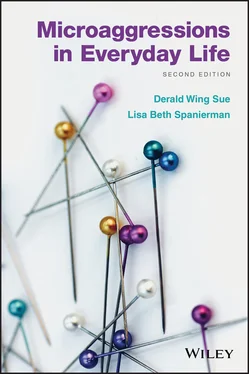1 ...7 8 9 11 12 13 ...19 Oftentimes undergirding efforts to trivialize and minimize microaggressions theory and research are notions that perpetrators neither want to change nor share their dominant‐group privileges with others. We have seen this among our White colleagues manifested in statements of moral superiority, such as “I could have interpreted your comment as an ageist microaggression toward me, but I didn't. Why are you so hypersensitive?”
Everything's a Microaggression in This Climate of Political Correctness
When critics argue that everything has become a microaggression, they are not acknowledging the larger sociohistorical context of oppression (Kraus & Park, 2017; Wong‐Padoongpatt & Rider, 2018). Instead, these critics imply that targets are like snowflakes, with weak character, who crumble in the face of the most trivial slights. Some contend that targets use “microaggression complaints” as a form of social control in a culture of victimhood (Campbell & Manning, 2018).
By recentering themselves, such critics ask, “Where do we draw the line?” and “Why am I made to feel like I am walking on eggshells?” They express concern about not being able to say what is on their minds and feel discouraged from even interacting with people from marginalized groups. What they do not ask is “What would it mean if the things I say and do actually have been hurtful to others?” What they do not consider is how interpersonal interactions that insult and invalidate someone's identity are linked to broader social forces—long‐standing hierarchies of dominance and oppression—that have powerful (and negative) effects on targets' well‐being.
The misunderstanding regarding flawed analysis takes shape both in the appraisal of empirical research on microaggressions (“Your research is invalid”) and in evaluations of targets' perceptions of their experiences (“Your accounts are inaccurate”). We find it curious that scholars who have no expertise in studies of racial discrimination feel authorized to step into the racial microaggressions literature, name the overall project, rename the construct, and call for persons who do not acknowledge the influence of racism in society to be involved in generating items for new measures designed to document experiences with microaggressions. If we understand them correctly, these critics are seeking a set of universal operating principles that we could use to identify microaggressions reliably across all persons from a particular marginalized group (see, e.g., Lilienfeld, 2017). We disagree with this idea of homogeneous microaggression experiences, and instead we acknowledge within‐group differences in how people interpret microaggressive statements. With a focus on context, we recommend investigations that seek to understand moderators (e.g., targets' interpretations) of the link between microaggressions and negative outcomes. Since the publication of the first edition of this book in 2010, there have been hundreds of studies conducted on microaggressions. In the chapters that follow, we draw from the research to document the current state of the field and signal directions for future investigation.
Critics also point to supposed flaws in the scientific investigation of microaggressions (e.g., Lilienfeld, 2017; Nagai, 2017). They claim that interview questions have been biased because they ask respondents directly about their experiences with subtle forms of discrimination (Nagai, 2017). As we describe in Chapter 7, purposive sampling, which refers to selecting respondents because they have substantial experience with the phenomenon of interest, is a common practice in rigorous qualitative research (Patton, 2015). Critics also offer related critiques of microaggressions research, such as small sample sizes (Nagai, 2017) and lack of validity of subjective reports (Lilienfeld, 2017) that generally are postpositivist critiques of qualitative research. We refer readers to Chapter 7, where we highlight the importance of methodological diversity (qualitative and quantitative) in psychological research.
When critics challenge reports of microaggressions from members of marginalized groups, we understand such reports as subtle and perhaps even unconscious expressions of dominance that reassert the power to define reality. The argument is that if it was not intended as a microaggression, then it is not one. For example, we often hear remarks such as “You're being hypersensitive” and “Maybe the gate agent reminds every person, regardless of race, that they are only boarding first class.” Sometimes there is a suggestion that naming the problem of microaggressions makes things worse. We have heard these statements: “ You may be the one promoting disharmony in our community because of the way you interpreted the event” and “People who complain about microaggressions are entrepreneurs of outrage.”
It is possible that dominant‐group members fear what it means to allow people who have been marginalized historically to give testimony to their experiences. A poignant example exists in Lee Mun Wah's video, Color of Fear, in which a group of men from different racial backgrounds come together for a retreat to discuss racism and race relations. Despite testimony after testimony about their experiences with racism from each of the men of color, one of the White participants, David, continually expresses doubt about the credulity of their accounts. He referred to them as “unfounded” and even implied that the men were blocking their own progress. During a tense moment in the group, Lee Mun Wah made a critical intervention when he asked David, “So what's keeping you from believing that that's happening to Victor (an African American man)?” David replied, “Because it seems like such a harsh life. And I just don't want to believe—I would assume, Victor, that your life is really that hard, difficult, and unpleasant.” Lee Mun Wah inquires further, “What if the world were not as you thought … [and subtle racism] actually is happening to lots of human beings on this earth. What would it mean to you?” Breaking down in tears, David clearly is overcome with sadness and says that he does not want to accept that humans can be so cruel.
Microaggressions, Marginality, and Harmful Impact
Earlier we stated that microaggressions can be directed at any marginalized group. Groups that are marginalized by our society exist on the margins (lower or outer limits) of social desirability and consciousness. We may view them in negative ways (undesirable) and/or be oblivious to their existence and life experiences. Many sociodemographic groups in the United States are defined by disability, class (poverty), and religion (Islam and Judaism); are confined to the edge of a system (cultural, social, political, and/or economic); and may experience exclusion, inequality, and social injustice. When microaggressions make their appearance in interpersonal encounters, they are reflections of marginality and a worldview of inclusion/exclusion, superiority/inferiority, desirability/undesirability, or normality/abnormality (D. W. Sue, 2003).
Like racial, gender, and sexual‐orientation microaggressions, microaggressions toward members of all marginalized social‐identity groups are a common and continuing experience in their lives. Microaggressions against these groups are plentiful, as indicated by the next examples.
A man with visual impairment reports that, when people speak to him, they often raise their voices. A well‐meaning nurse was actually “yelling at him” when giving him directions on taking his medication. He replied to her: “Please don't raise your voice, I can hear you perfectly well.” (Hidden message: A person with a disability is defined as lesser in all aspects of functioning.)
Читать дальше












